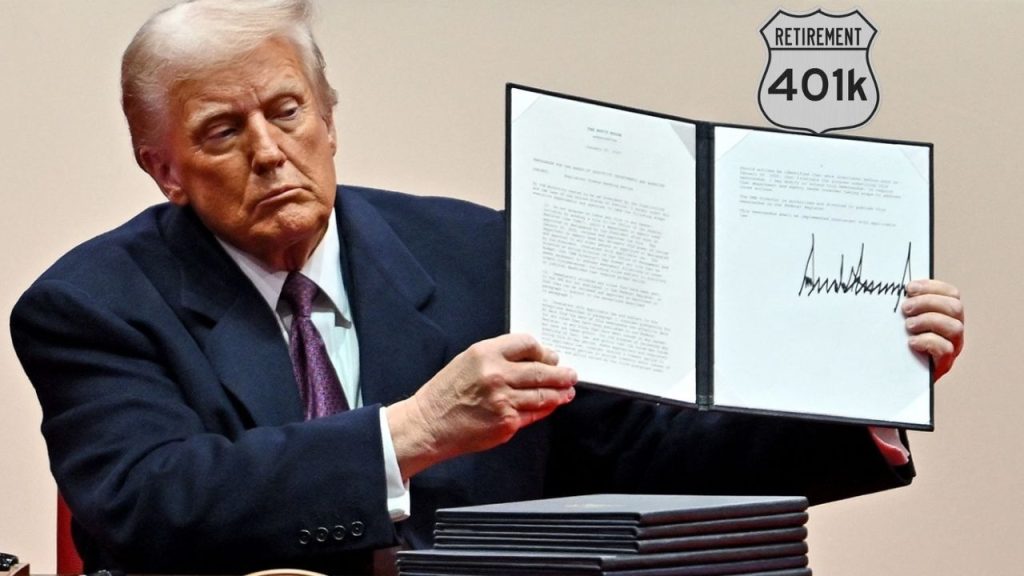In August 2025, President Donald Trump signed a landmark executive order aimed at expanding investment options in 401(k) retirement plans by allowing more access to alternative assets such as private equity, cryptocurrency, and real estate. This executive order, titled “Democratizing Access to Alternative Assets for 401(k) Investors,” has stirred significant debate among experts, retirement savers, and particularly within the Black community. Concerns are mounting that this shift may put Black Americans’ retirement security at risk.

While the changes promise greater potential returns and diversification, they come with increased risk, complexity, and potential unequal impacts. This article breaks down the key facts about Trump’s 401(k) plan changes, explains its implications, especially for Black retirement security, and offers practical advice for all retirement savers.
Trump’s 401(k) Plan Sparks Fears Over Black Retirement Security
| Topic | Key Points |
|---|---|
| Executive Order Name | Democratizing Access to Alternative Assets for 401(k) Investors |
| Date Signed | August 7, 2025 |
| Expanded Investment Options | Private equity, crypto, real estate, commodities, infrastructure, and lifetime income strategies |
| Goal | Broaden access to potentially higher returns and diversify 401(k) portfolios |
| Targeted Impact | Over 90 million Americans with defined-contribution plans |
| Concerns Raised | Increased investment risk, regulatory complexity, and disproportionate effects on Black workers |
| Regulatory Agencies Involved | U.S. Department of Labor (DOL), Securities and Exchange Commission (SEC), U.S. Treasury |
| Fiduciary Duties | Plan fiduciaries must carefully vet alternative asset offerings for risk and return balance |
| Public Reaction | Mixed; many retirees skeptical, especially about risk and suitability |
| Official 401(k) Resource | U.S. Department of Labor – 401(k) Plans |
Trump’s 2025 executive order opens the door for 401(k) savers to explore alternative assets with the promise of higher returns and new diversification opportunities. However, this shift brings increased risks, complexity, and important fiduciary responsibilities for plan sponsors and investors alike.
For Black Americans and other vulnerable groups, the challenge is greater due to existing wealth and financial education disparities. Savers should approach new investment options cautiously, balancing growth goals with measured risk and ongoing education.
Understanding these changes with clarity and care can help all investors make better retirement decisions in a rapidly evolving landscape.
What Is Trump’s 401(k) Executive Order About?
President Trump’s executive order aims to make it easier for retirement savers to invest in alternative assets through employer-sponsored 401(k) plans. These assets include private equity (ownership stakes in private companies), cryptocurrency, real estate, commodities, and more. Historically, such investments have been limited to institutional investors, public pension funds, and high-net-worth individuals.

The executive order directs federal agencies—primarily the Department of Labor (DOL), the Securities and Exchange Commission (SEC), and the Treasury—to revise regulations and provide guidance that supports broader retirement plan access to these investments. The administration believes this could offer everyday Americans a chance to gain higher returns and diversify their portfolios beyond traditional stocks and bonds.
Why Are Alternative Assets Riskier?
Alternative assets differ fundamentally from stocks and bonds in several ways:
- Less Liquidity: Unlike stocks, which trade daily, alternative assets often require long holding periods and cannot be easily sold quickly.
- Higher Fees: Private equity and other illiquid investments can carry higher management fees, which can eat into returns.
- Market Transparency: These assets are less regulated and less transparent, making it harder for savers to evaluate risks clearly.
- Complexity: Understanding valuations and potential returns from these investments demands significant financial knowledge.
For instance, investing in private companies might sound lucrative, but the risk of losing capital is high if these businesses underperform. Similarly, cryptocurrency prices can be volatile, with sudden large fluctuations common.
Impact on Black Retirement Security
Black Americans face unique challenges regarding retirement security:
- Wealth Gap: On average, Black households hold significantly less wealth than their white counterparts, resulting in smaller retirement account balances.
- Financial Education: Studies show disparities in financial literacy and access to resources, making it harder for some Black savers to assess complicated investment options.
- 401(k) Reliance: For many Black workers, 401(k) plans are their primary or only source of retirement savings, increasing the stakes if these plans carry higher risks.
Experts warn that while alternative assets could boost returns, the increased complexity and risk may disproportionately jeopardize Black retirement readiness. A risky asset allocation might lead to significant losses, especially for those unable to absorb downturns or seek diversified advice.
Practical Tips for 401(k) Savers
1. Understand Your Plan’s Investment Options
Check whether your 401(k) plan offers alternative assets and carefully review what they entail. Look for detailed descriptions and past performance, understanding that past gains are never guaranteed.
2. Assess Your Risk Tolerance
Your retirement timeline, financial goals, and comfort with volatility should guide any decision to allocate funds to higher-risk investments. Younger savers might tolerate risk better than those nearing retirement.
3. Seek Professional Advice
If alternative assets are introduced in your plan, consider consulting a certified financial planner or retirement adviser. They can help weigh risks and help optimize your investment mix.
4. Monitor Your Account Regularly
Diversify your holdings and review them periodically to ensure they align with your goals and risk appetite. Be cautious of high fees or poorly performing investment options.
5. Educate Yourself
Use reliable sources like the U.S. Department of Labor’s retirement resources and trusted financial websites to understand investment types and retirement planning better.
How Are Regulators Responding?
The Department of Labor has been instructed to revisit its guidance on fiduciary duties related to alternative assets, with expectations for new rules that balance encouraging innovation while protecting savers. The SEC and Treasury are also working to clarify disclosure and tax implications, including unrelated business taxable income (UBTI) concerns for 401(k) plans investing in commercial ventures.
While regulatory updates are underway, some lawmakers and consumer advocates express concern about protecting vulnerable investors and avoiding supervisory gaps that could lead to losses or fraud.
Americans Are Raiding 401(k) Accounts for Cash — Why Experts Say It Should Be Your Last Resort
401(k) Millionaires Are Surging in 2025 — Here’s How Savers Are Hitting the Jackpot
Trump Opens Door to Crypto in 401(k)s — What It Means for Your Retirement
FAQs About Trump’s 401(k) Plan Changes
Q1: What are alternative assets?
A1: Alternative assets include investments beyond stocks and bonds, such as private equity, real estate, cryptocurrencies, commodities, and infrastructure projects.
Q2: Will everyone’s 401(k) plan include alternative assets now?
A2: No. The executive order encourages access but does not mandate that plans add these options. Plan sponsors and fiduciaries will choose what to offer based on suitability and risk.
Q3: Are alternative assets suitable for everyone?
A3: Not necessarily. They can be riskier and less liquid, so they may not be appropriate for those close to retirement or risk-averse savers.
Q4: How can I protect my retirement savings?
A4: Stay informed, diversify your portfolio, seek professional advice, and regularly review your account. Focus on long-term goals rather than chasing quick returns.
Q5: Where can I learn more about my 401(k) and retirement planning?
A5: Trusted resources include the U.S. Department of Labor’s 401(k) Plan FAQs and financial education from reputable organizations such as the CFP Board and AARP.






